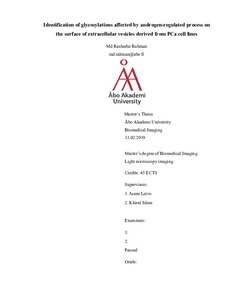Identification of glycosylations affected by androgen-regulated process on the surface of extracellular vesicles derived from PCa cell lines
Rahman, Md Rashedur (2019)
Rahman, Md Rashedur
Åbo Akademi
2019
Julkaisu on tekijänoikeussäännösten alainen. Teosta voi lukea ja tulostaa henkilökohtaista käyttöä varten. Käyttö kaupallisiin tarkoituksiin on kielletty.
Julkaisun pysyvä osoite on
https://urn.fi/URN:NBN:fi-fe201903219649
https://urn.fi/URN:NBN:fi-fe201903219649
Tiivistelmä
Introduction: Prostate cancer (PCa) is one of the leading death-causing cancers in males. Lack of sensitivity of the current diagnostic approach created an opportunity for a new diagnostic method. Altered glycosylation is a well-known phenomenon in cancer and can be used as an essential hint for identification of biomarkers of cancer. In this research, the aim is to identify glycosylation from PCa cell line on extracellular vesicles (EVs) which is regulated by the androgen hormone using a variety of lectins.
Methods: The LNCaP, a PCa cell line, was treated with androgen hormone agonist DHT (R1881) and antagonist enzalutamide (MDV3100). Then EVs were isolated from hormone-treated and untreated LNCaP cell culture medium. Then EVs were captured by biotinylated anti- CD9.C11 which was immobilized in a streptavidin-coated microtiter plate with EU+3-coated nanoparticles (NPs) conjugated with lectins was used to detect the surface glycan of EVs. To maintain an equal amount of EVs in each well, 800ng total protein was added.
Results: Among twenty-four screened lectins, UEA (Ulex europaeus Agglutinin) presents a considerable amount of fluorescence signal to the EVs from the LNCaP cell line. We noticed that fucosylation in EVs-derived from LNCaP cell was increased by R1881 and decreased by MDV3100 which is indicated by the fucose-binding lectin UEA. Antibodies against tetraspanins were conjugates with NPs which was used for normalizing signal. Our results give a hint for androgen hormone and EVs glycosylation for detecting PCa from the simple assay.
Conclusion: Influence of glycosylation and androgen in PCa is a well-studied phenomenon. Therefore, identification of glycosylation in the surface of EVs from the simple lectin-NPs technique would be a useful approach for EVs-based cancer diagnosis.
Methods: The LNCaP, a PCa cell line, was treated with androgen hormone agonist DHT (R1881) and antagonist enzalutamide (MDV3100). Then EVs were isolated from hormone-treated and untreated LNCaP cell culture medium. Then EVs were captured by biotinylated anti- CD9.C11 which was immobilized in a streptavidin-coated microtiter plate with EU+3-coated nanoparticles (NPs) conjugated with lectins was used to detect the surface glycan of EVs. To maintain an equal amount of EVs in each well, 800ng total protein was added.
Results: Among twenty-four screened lectins, UEA (Ulex europaeus Agglutinin) presents a considerable amount of fluorescence signal to the EVs from the LNCaP cell line. We noticed that fucosylation in EVs-derived from LNCaP cell was increased by R1881 and decreased by MDV3100 which is indicated by the fucose-binding lectin UEA. Antibodies against tetraspanins were conjugates with NPs which was used for normalizing signal. Our results give a hint for androgen hormone and EVs glycosylation for detecting PCa from the simple assay.
Conclusion: Influence of glycosylation and androgen in PCa is a well-studied phenomenon. Therefore, identification of glycosylation in the surface of EVs from the simple lectin-NPs technique would be a useful approach for EVs-based cancer diagnosis.
Kokoelmat
- 3111 Biolääketieteet [11]
